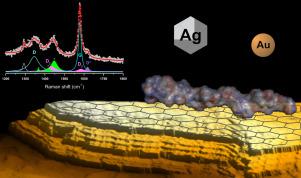带有等离子纳米粒子的石墨烯-壳聚糖复合材料中的超分子相互作用
IF 3.1
Q2 MATERIALS SCIENCE, MULTIDISCIPLINARY
引用次数: 0
摘要
石墨烯与壳聚糖等生物聚合物之间的超分子相互作用决定了是否会形成纳米结构杂化材料及其技术上相关的物理/化学特性。然而,人们对基于壳聚糖和石墨烯的纳米复合材料是如何形成的,以及它们的内在结构和与等离子纳米粒子的相互作用仍然缺乏基本的了解。在这项工作中,我们深入了解了壳聚糖和石墨烯在与金或银纳米粒子形成石墨烯-壳聚糖纳米复合材料过程中的超分子相互作用。为此,我们将拉曼光谱、傅立叶变换红外光谱、原子力显微镜、扫描电子显微镜、X 射线光电子能谱测量与密度泛函理论计算相结合,揭示了石墨烯与壳聚糖之间超分子相互作用的机理和驱动力。具体来说,我们发现它们是基于壳聚糖胺基在酸性介质中质子化所产生的电荷转移过程。我们在此提供的对石墨烯与壳聚糖之间超分子相互作用的理解,应能证明对材料科学和生物医学工程领域具有重大意义和兴趣。本文章由计算机程序翻译,如有差异,请以英文原文为准。

Supramolecular interactions in graphene–chitosan composites with plasmonic nanoparticles
The supramolecular interactions between graphene and biopolymers, such as chitosan, determine both whether nanostructured-hybrid materials are formed and their technologically relevant physical/chemical properties. However, there is still a fundamental lack of knowledge about how nanocomposites based on chitosan and graphene are formed, as well as their intrinsic structure and interaction with plasmonic nanoparticles. In this work, we provide an in-depth understanding of the supramolecular interactions between chitosan and graphene in the formation of graphene–chitosan nanocomposites with gold or silver nanoparticles. To do so, we employ a combination of Raman spectroscopy, Fourier-transformed infrared (FTIR) spectroscopy, atomic force microscopy (AFM), scanning electron microscopy (SEM), and X-ray photoelectron spectroscopy (XPS) measurements with density functional theory (DFT) calculations to reveal the mechanism and driving forces behind these supramolecular interactions between graphene and chitosan. Specifically, we show they are based on a charge transfer process derived from the protonation of the amine groups of chitosan in acidic media. The understanding of the supramolecular interaction between graphene and chitosan that we provide herein should prove of great importance and interest to the material sciences and biomedical engineering fields.
求助全文
通过发布文献求助,成功后即可免费获取论文全文。
去求助
来源期刊

Carbon Trends
Materials Science-Materials Science (miscellaneous)
CiteScore
4.60
自引率
0.00%
发文量
88
审稿时长
77 days
 求助内容:
求助内容: 应助结果提醒方式:
应助结果提醒方式:


